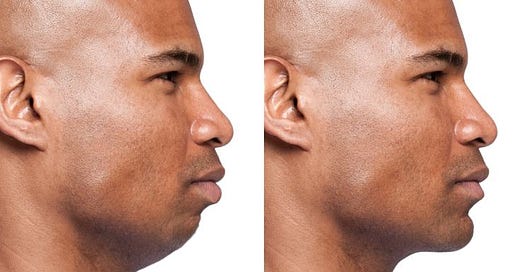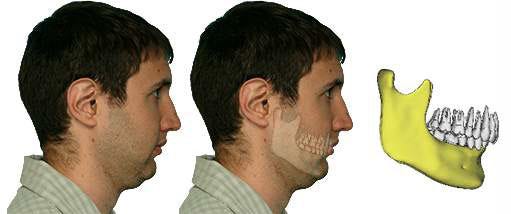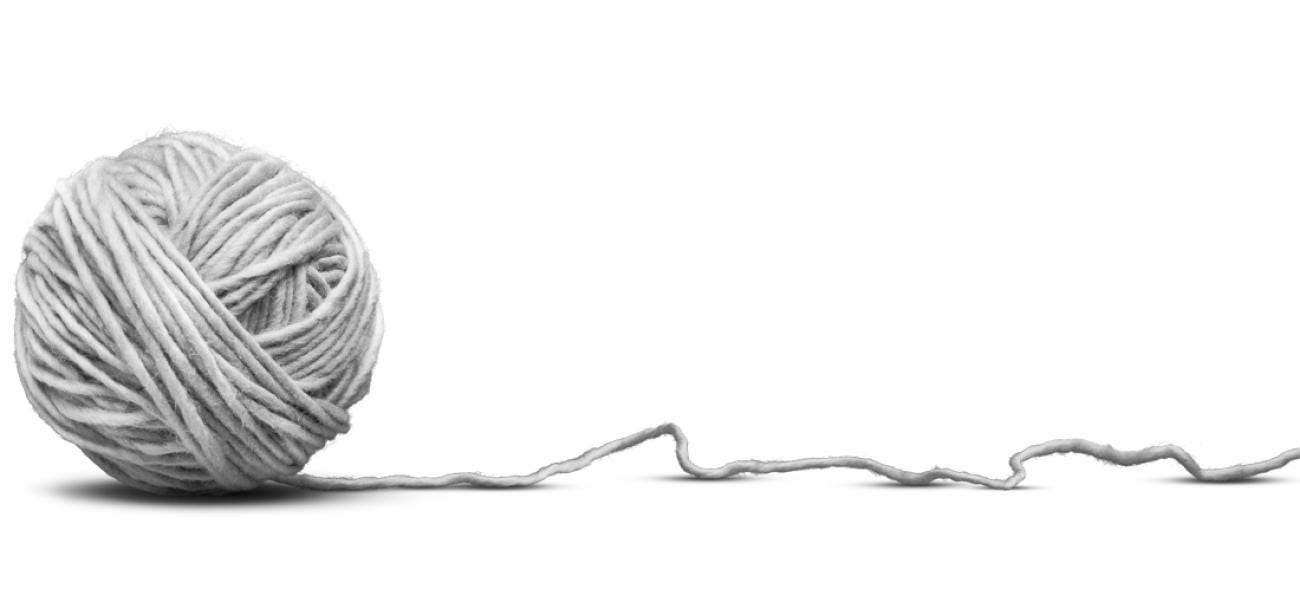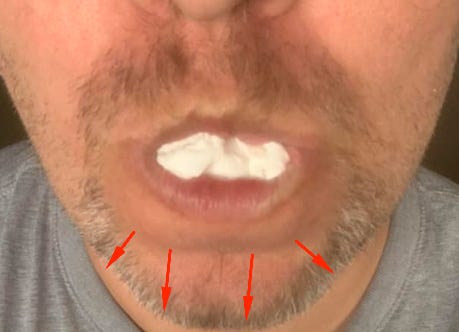Does this process help a recessed jaw?
Yes I view that it does and now I'll explain the mechanic behind why.
A recessed jaw seems to be the enemy of every GenZer these days.
You never really heard young people talk about it back when I was a kid in the 80’s.
Rather the only kids that got teased were the overweight ones or the nerds.
But now it almost feels like having a recessed jaw is even worse than being overweight. And it can happen to skinny people as well.
As a result it feels like things like double jaw surgeries are rocketing up in popularity. I see really young people taking this step or considering it more and more.
Hell there are popular Tiktok channels completely dedicated to double jaw surgery. I have a couple young ladies that frequent my feed and give updates on how they’re recovering from their double jaw surgery.
All in the pursuit of that gold standard profile.
Ok… time to give my perspective on all this.
What is Meant by a Recessed Jaw?
A recessed jaw refers to a condition where one or both jaws appear to sit further back than their ideal anatomical position.
This creates a facial profile in which the jaw doesn't project forward adequately, often resulting in a weak chin, compressed airways, and an overall lack of facial balance.
Visually, someone with a recessed jaw will often have a "weak" side profile, where the chin appears to fade into the neck rather than creating a strong, defined jawline. The lower face may look shortened or compressed.
This will typically affect both function and aesthetics, potentially impacting breathing, chewing, speaking, and overall facial harmony.
What are the Types of Jaw Recession?
According to the current way of thinking of most medical practitioners in this area… jaw recession manifests in several distinct forms, each affecting different aspects of facial structure and function.
Mandibular retrusion involves the lower jaw (mandible) sitting too far back relative to the upper jaw and skull. This is perhaps the most commonly recognized form of jaw recession, creating the classic "weak chin" appearance. People with mandibular retrusion often have difficulty with proper tongue posture and may experience sleep-disordered breathing due to reduced airway space behind the tongue.
Maxillary retrusion occurs when the upper jaw (maxilla) is positioned too far back. This condition can create a flat or concave midface appearance, with the cheekbones appearing less prominent and the nasal area looking compressed. Maxillary retrusion often contributes to a "dish face" profile and can significantly impact nasal breathing and sinus function.
Bimaxillary retrusion iswhere both the upper and lower jaws are positioned too far back. This creates a compressed facial appearance with minimal projection in both the midface and lower face regions. People with bimaxillary retrusion often have the most severe functional impacts, including significant breathing difficulties, speech challenges, and aesthetic concerns.
What do they say causes this?
Modern medical and dental science attributes jaw recession to mainly genetic predisposition and developmental issues.
The conventional explanation centers on insufficient bone growth during crucial developmental periods, leading to underdeveloped jaw structures that fail to reach their full potential size and projection.
Environmental factors are also commonly cited, including mouth breathing during childhood, thumb sucking, prolonged pacifier use, and poor tongue posture. These habits allegedly interfere with normal facial development by altering the natural forces that guide jaw growth.
Additionally, the modern diet featuring soft, processed foods are thought to reduce the mechanical stimulation necessary for proper jaw development.
How do people typically try to fix it?
Current treatment methods reflect this understanding and typically involve mechanical interventions designed to either move existing bone structures or stimulate additional growth.
Orthodontic treatments like braces and functional appliances attempt to guide jaw positioning and encourage development.
More aggressive approaches include orthognathic surgery, where surgeons physically cut and reposition jaw bones to achieve better alignment and projection.
Mewing advocates for tongue posture exercises designed to apply upward pressure to the palate, theoretically encouraging "forward growth" of facial structures.
Despite these interventions, many patients report limited long-term success, with most experiencing regression over time or requiring multiple treatments to maintain “results”.
Now for my view on how it works
I take a pretty different view from the one stated above.
I view that the soft tissue covering the skull essentially deflated like a balloon. Something I talk about here.
This ends up crushing everything inside. Cranial bones derange and the jaw displaces in three dimensions like an airplane.
Meaning that it will often get jacked back, twist to the side, and rotate downwards.
The TMJ joint of course is impacted because that is the soft tissue connection of the jaw to the skull. And the cervical spine will also ‘collapse’ together with the profile in my experience.
So it’s a problem not just of fixing the position of your jaw… but rather resurrecting your entire cervical spine. And to do that you need to also fix your entire spine to some extent.
And therein lies the flawed thinking of all of the current approaches to fixing this issue. They are focused only on the position of the jaw while forgetting that you need to fix the entire spine and skull with it.
Otherwise it will not be stable. And this is why all of these jaw surgery patients will pretty much always be disappointed later on and have to keep getting things fixed.
Because the rest of the spine will continue to ruin the surgeon’s work as the person’s collapse cycle continues.
I have not seen a single exception to this in all of my years of paying attention to folks that did surgery. Sure it looks good initially… but look at what that person looks like as time goes on.
Show me the double jaw surgery patient that ‘fixed’ a very recessed jaw and still looks solid a decade later. IT DOES NOT HAPPEN.
Now for my view on how to fix it
There is only one long-term way to fix the problem of a recessed jaw. And you guessed it.. it is biomechanics.
You need to re-inflate the entire skull and skeleton. This allows the cranial bones and the jaw to revert to their healthy, correct anatomical position. And in the process you are essentially putting the cervical structures back into place like fixing a collapsed building.
I’ve done this to myself a several times in the past decade to various extents, but had always screwed it up as I didn’t understand the entire puzzle. Now I’m pretty confident I do and so I consider that I am doing it for the last time. And will show how it works at the end.
What happened when I did this ‘to the end’ back around 2016 went something like this.
I kept doing my ‘fast method’ stretches and the chin area of the jaw got redder and redder as if the skin was stretching.
As it stretched it felt as if the soft tissue was a tangled ball of yarn and I was unraveling it. As it unraveled the tissue my skull inflated and my profile improved.
Till finally at the end the skin got so stretched & red that it broke. Not just in the chin area but all around my jaw and even parts of my face. Like a bad sunburn the skin flaked off.
The jaw ended up freeing up as if it was like a tennis ball that popped out from underneath a rug (ie. the soft tissue that was holding it out of place).
And when that happened my whole spine corrected together with my profile. I felt taller and probably literally was. I was also more symmetric than I’d been probably my entire adult life.
Closing Thoughts
In my view what I just described is the true reason why folks have a recessed profile and how they correct in a stable way.
If you take my tennis ball trapped underneath the rug analogy you start to realize that surgery does nothing helpful. The jaw is trapped out of position because of soft tissue and you just start cutting.
But the skull is still deflated and instead of inflating it to make room for everything to go back to its proper position.. you are instead just moving things around inside this deflated balloon.
Which will cause it to just deflate further in the years following. Causing more assymetry and more health issues.
Which is pretty much exactly what all of these jaw surgery patients will eventually experience.
You do not fix jaw recession without fixing the entire skull & skeleton…. period.


















How can I convince my biomechanically (and so neurologically) collapsed parents to wear Reviv, considering they've been brainwashed by traditional treatments and struggle to accept such a major shift in mindset?
Where can I get this reviv from?